Ready, Set, Create: Engineers Inspiring Youth to Build Their Dreams
Connected Science Learning May-June 2021 (Volume 3, Issue 3)
By Jennifer Jocz, Paul Dusenbery, Keliann LaConte, and Jeannine Finton
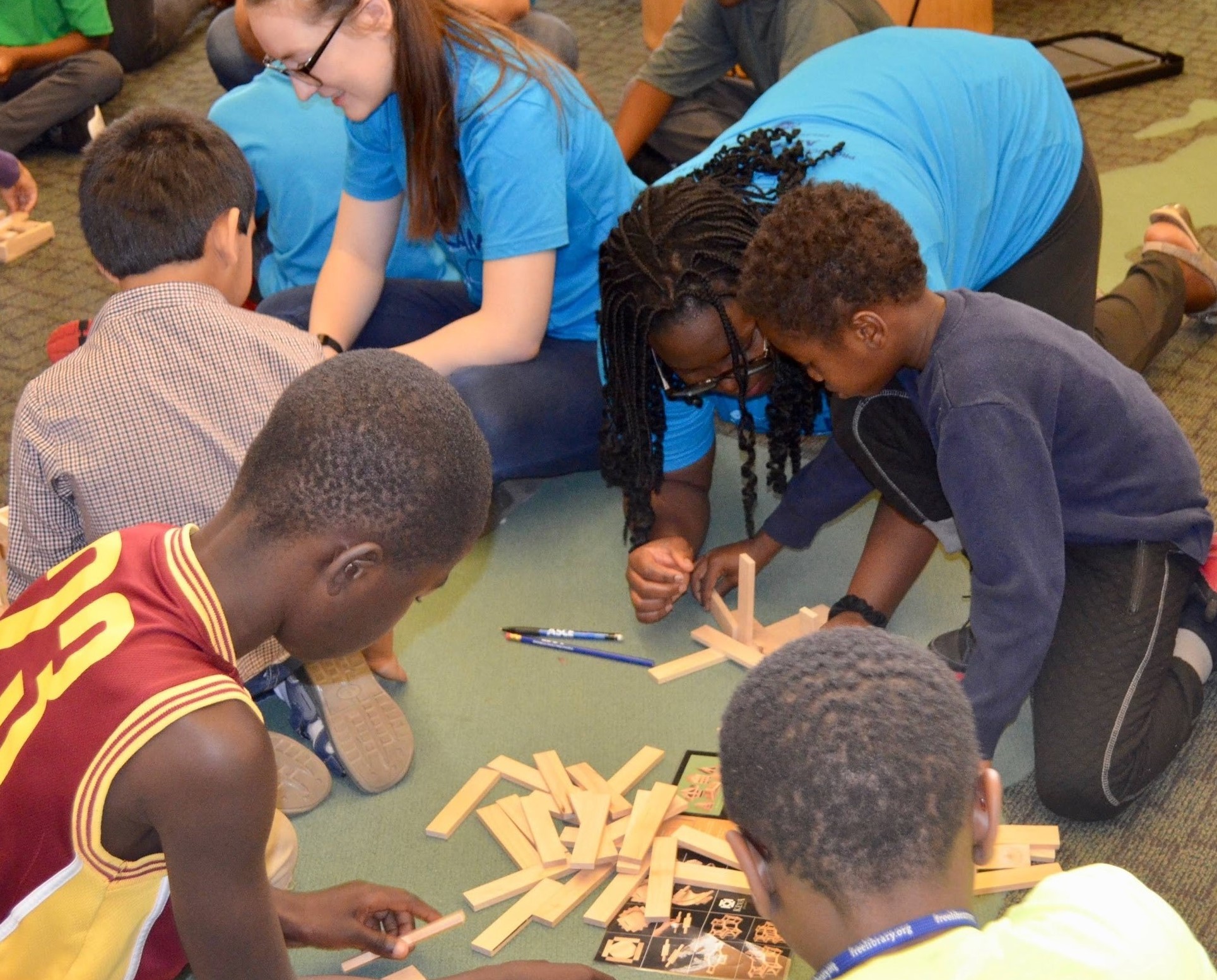
It’s a Saturday morning and a group of elementary-age children are gathered around tables at their local library. Volunteer engineers introduce themselves. One says, “I’m Sara. I’m a water engineer, which means I help keep our drinking water safe and clean for everybody.” Another mentions, “I’m an engineering student. I would like to do civil engineering and help with our waterways. I hope you guys follow in my footsteps.” Over the course of an hour, the engineers and library staff work with the kids to design, test, and redesign solutions to everyday challenges, such as providing clean water or powering our neighborhoods. Using everyday materials like notecards, straw, and modeling clay, youth can act like engineers, exploring, discovering, and creating their own designs with support from the engineers and library staff in the room. The kids are excited to talk about their creations and proudly show off their work to their caregivers at pickup. This is just one example of how Ready, Set, Create library programs supports youth in practicing engineering-related skills in a fun, engaging manner.
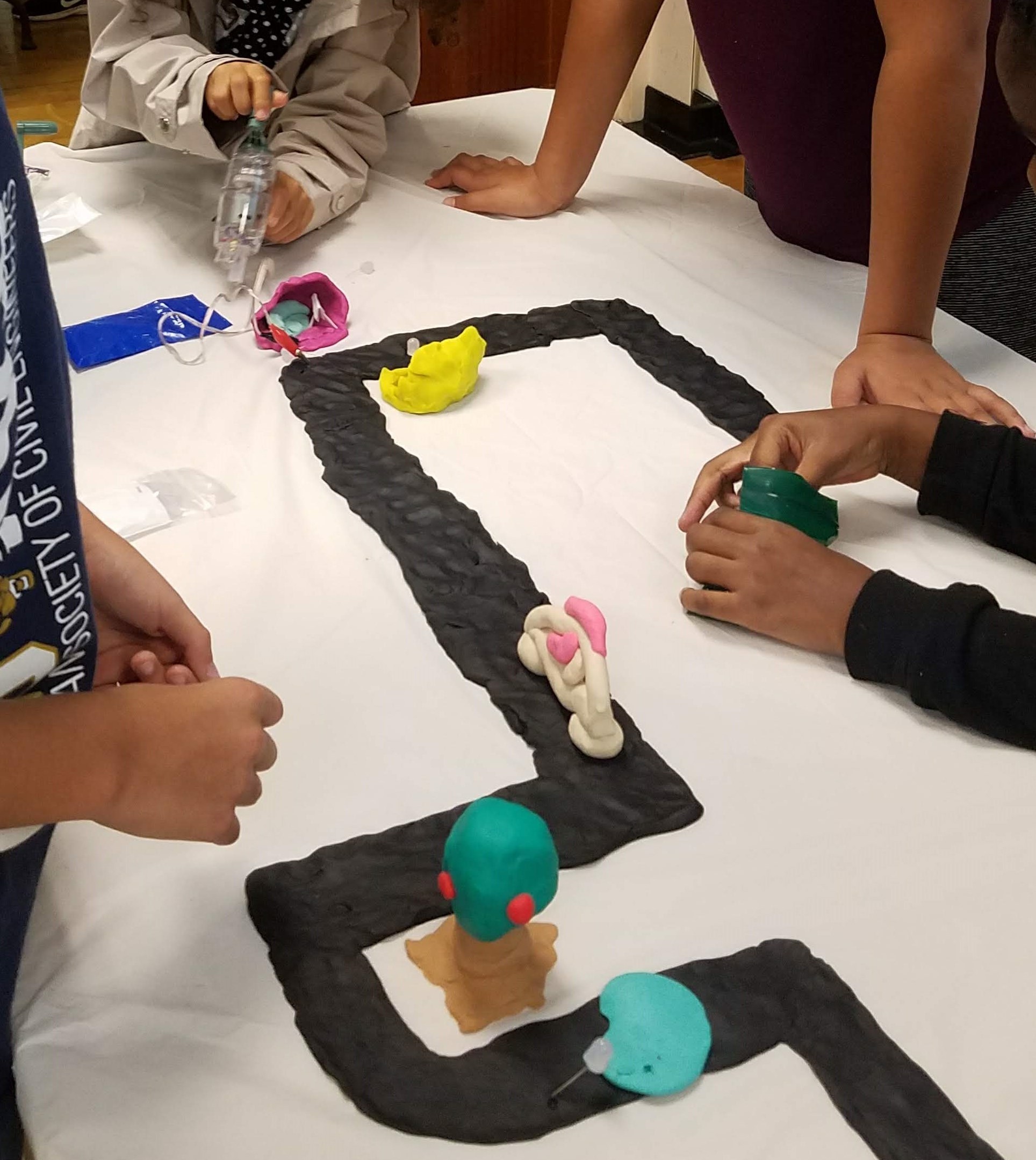
In the 21st century, a basic understanding of science, technology, engineering, and math (STEM) is part of being an informed and engaged citizen (Institute for Museum and Library Services 2009). However, research demonstrates that by the time youth reach fourth grade, a third of all students have lost interest in science and by eighth grade nearly 50 percent of students have deemed science and technology as irrelevant to their future career plans (e.g., Tai et al. 2006). A growing body of evidence shows that individuals develop their interests in STEM through participation in activities across a variety of settings. These include home, school, informal/free-choice learning organizations and institutions, and a range of virtual environments, all shaped by rapidly evolving digital media and interactions with peers and adults (e.g., Bathgate et al. 2013; Ito et al. 2013). The National Research Council (NRC 2009) concluded that learning experiences across informal environments positively influence science learning in school, attitudes toward science, and pursuit of science‐related occupations. Public libraries are one such environment, providing free resources, STEM programming, and space to their communities. In 2017, America’s 17,000 libraries and bookmobiles engaged 118.4 million Americans in library programs (a 44% increase since 2008) (Institute of Museum and Library Services 2020). Additionally, public libraries are particularly ideal for reaching audiences typically underserved in STEM, serving people of all races, ages, and socio-economic backgrounds.
With this in mind, the Space Science Institute’s (SSI) National Center for Interactive Learning (NCIL), in partnership with the University of Virginia (UVA) and the American Society for Civil Engineers (ASCE), secured a grant from the National Science Foundation (NSF) to develop and implement Project BUILD (Building Using an Interactive Learning Design). Six public libraries across the country (three rural and three urban) along with their engineer partners participated in the project. The ultimate goal of Project BUILD is to increase youths’ awareness of and motivation to pursue STEM-related educational and career pathways, especially for youth from rural and/or geographically isolated areas and youth from populations traditionally underrepresented in STEM. Project BUILD is part of NCIL’s STAR Library Network portfolio that helps library professionals build their STEM skills by providing “science-technology activities and resources” (STAR) and training to use those resources.
To achieve its goals, Project BUILD used the following activities:
- Community Dialogues: Project BUILD libraries hosted at least one Community Dialogue event to engage representatives from their community (e.g., local business/industry, community organizations, Girl and Boy Scout leaders, 4-H, homeschool groups, caregivers, and teachers) in conversations with a focus on reaching groups in their local area that are currently underrepresented in STEM professions. More information and resources related to Community Dialogues, can be found on the STAR Net website.
- Circulating Kits and In-house Learning Centers: Library staff developed and circulated take-home kits containing hands-on, engineering-related activities for patrons to engage with at home. Some libraries also had these activities set up at Learning Centers for use in the library.
- Ready, Set, Create In-Person Library Programs: Library staff and engineers co-facilitated a series of four hands-on library-based programs for youth in grades 2–5 under the name Ready, Set, Create.
- Dream, Build, Create Virtual Programs: Created in response to the COVID-19 pandemic, Dream, Build, Create involved virtual screenings of the Dream Big: Engineering Our World documentary and live virtual presentations by “Dream Teams” featuring diverse engineers. These activities were targeted at grades 4 and up.
This article discusses the two components of Project BUILD involving direct contact between engineers and youth. It focuses on Ready, Set, Create in-person library programs, which were the focus of the project, and then highlights the virtual Dream, Build, Create program developed as a way to connect engineers with the public during the COVID-19 pandemic. Although these activities took place largely in out-of-school settings, the lessons learned are also relevant to any setting where educators are interested in partnering with STEM professionals to co-facilitate learning activities.
In-Person Ready, Set, Create Library Programs
A major component of the project was a series of four library programs promoted under the name Ready, Set, Create. These programs, conducted once a month for one to two hours, brought together public library staff and engineers to engage youth in grades 2–5 in hands-on, age-appropriate, technology-rich, engineering-related learning experiences. A Framework for K–12 Science Education (NRC 2012) provided an important age-appropriate framework for the design of the programs, particularly the ideas related to the Engineering/Technology domain that covered the engineering design process. Like in the well-established Portal to the Public framework for connecting scientists with public audiences (e.g., Storksdieck et al. 2017), the engineer-youth interactions were focused on dialogue and hands-on experiences.
Program topics included: Span-tastic Bridges: From Here to There, Designed to Survive: Engineering for Disasters, Clean Up Our World, and Power From Nature. Activities were selected/adapted from engineering activities developed for Dream Big: Engineering Our World, a giant-screen documentary, as well as TeachEngineering, and resources suggested by librarians. For example, in the activity Surviving Storm Surge, youth played the role of engineers as they designed and built paper houses on a “coast” made out of modeling clay. The model landscape was then flooded with water to see if the house they made could withstand the rising tide. After observing what happened, youth were encouraged to improve their designs and try again. In total, over 300 youth participated in Ready, Set, Create library programs.
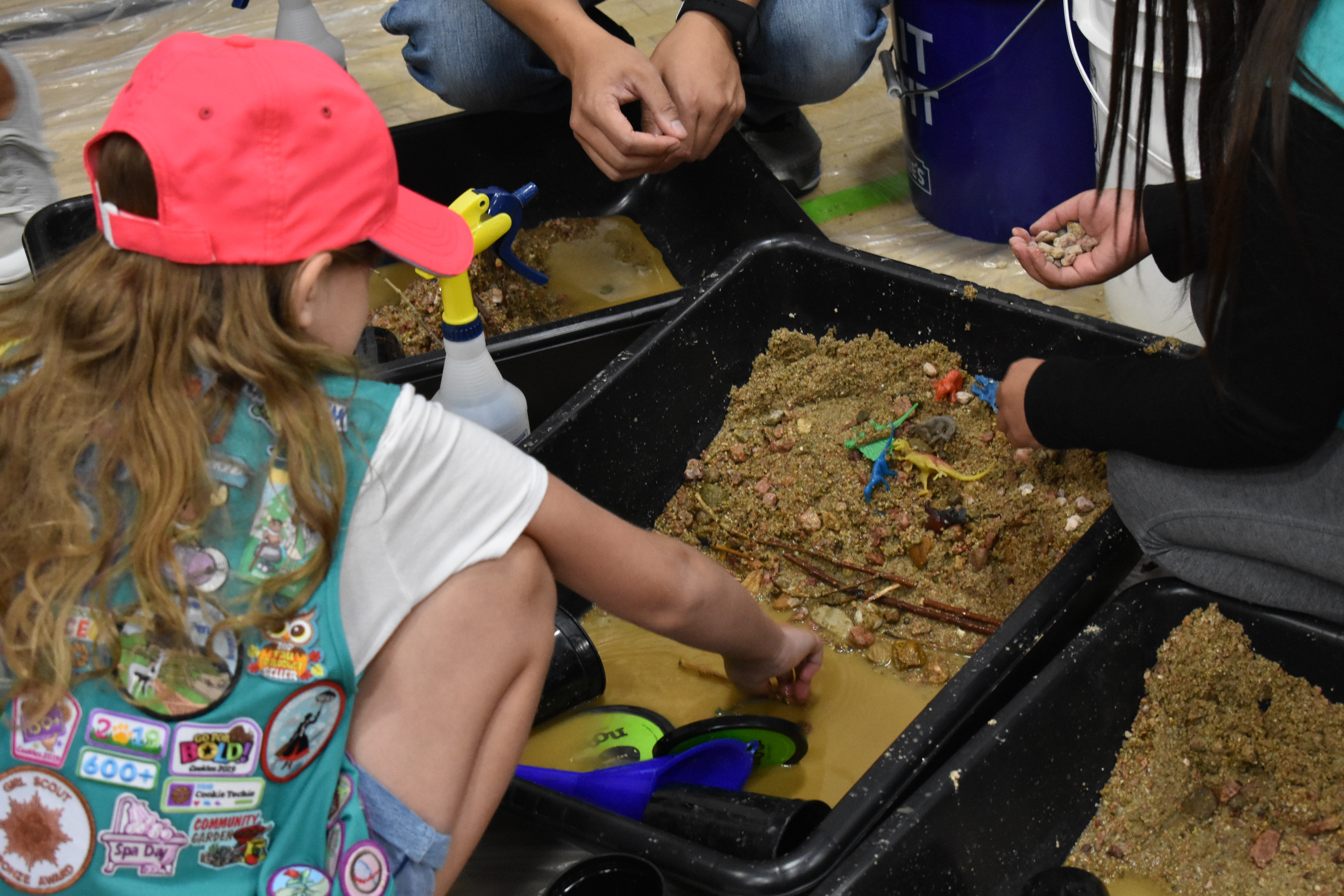
Activities for each of the programs and additional resources, including how-to videos, tips for use in a library setting, book suggestions, family guides, and more, are all available online through the STAR Library Network (STAR Net).
Designing Engineering Activities for Public Libraries
Ready, Set, Create library programs were designed around three main philosophies. Activities should
- teach engineering-related skills such as collaborative teamwork, problem solving, and creativity;
- provide opportunities for youth to use the Engineering Design Process (EDP) to test multiple designs, highlighting that failure is just the next step toward success (see Figure 1); and
- be interesting, engaging, and fun by incorporating features that are challenge-focused, technology-rich, and age-appropriate.
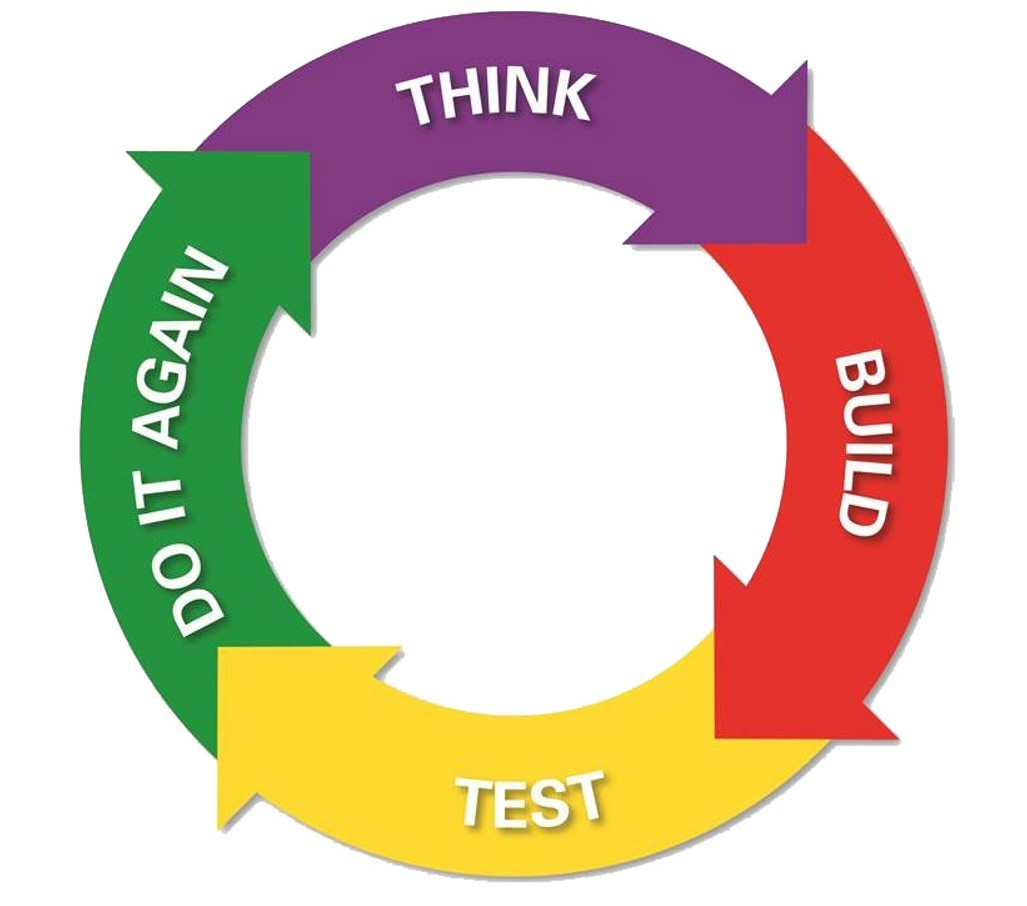
Programs also aimed to communicate the following key engineering messages, which focus less on the factual aspects of engineering and more on the inspirational messages that might encourage a child to consider engineering as a career (National Academy of Engineering 2013):
- Engineers make a world of difference
- Engineers are creative problem solvers
- Engineering is essential to our health, happiness, and safety
- Engineers help shape the future
Preparing Engineers and Library Staff to Engage Youth
A key element of Project BUILD was including civil engineers from ASCE in the co-delivery of library programs along with library staff. ASCE represents more than 150,000 members of the civil engineering profession in 177 countries. Attracting youth to the profession is one of ASCE’s top priorities, so it maintains a robust pre-college outreach program with an active volunteer network that matches engineers with needs at local schools and community organizations.
Participating library staff and engineers received online and in-person training on the specific hands-on activities as well as facilitation techniques. They were taught to serve as a “guide on the side” instead of a “sage on the stage.” The “guide on the side” approach uses questioning that accesses prior knowledge and experiences; lively discussions that encourage deep thinking; and a fun, engaging environment in which there are no “wrong” answers. (See the STAR Net website for more information about the “Guide on the Side” approach to facilitation.)
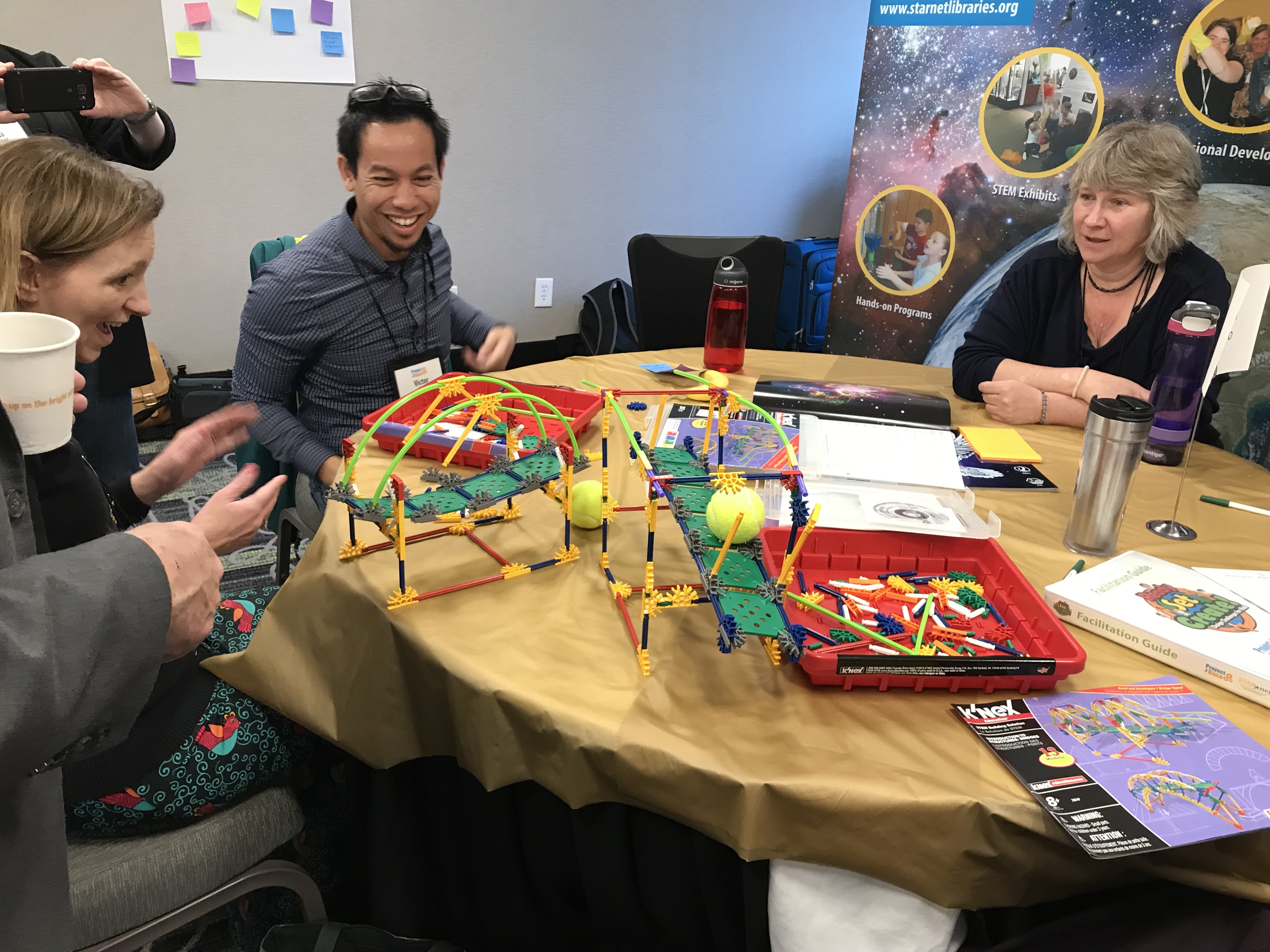
Project Outcomes for Facilitators
The project’s evaluation used mixed methods to investigate the implementation and influence of Project BUILD activities. All library staff and volunteer engineers who helped facilitate a program in the final year of the project completed a survey to better understand their experiences and views. Lead library staff and engineers from all six sites were also interviewed to gain further insights into their experience over the course of the project. Findings indicate that this partnership enhanced the capacity of libraries to offer hands-on engineering-related programming, provided role models for children, and improved the ability of engineers to inspire youth.
As shown in Figure 2, results from these surveys and interviews revealed that, overall, library staff and engineers had increased interest, knowledge, and confidence in facilitating engineering-related programs with youth after their experience with the project. Library staff gained confidence and knowledge in offering STEM-related programming as well as a better understanding of engineering in general. Engineers learned about facilitating activities with young children and enjoyed reaching new audiences, especially underserved audiences. On the post-survey, most library staff (85%) and engineers (90%) reported that, because of this experience, they are very likely to facilitate additional engineering-related youth programming in the future.
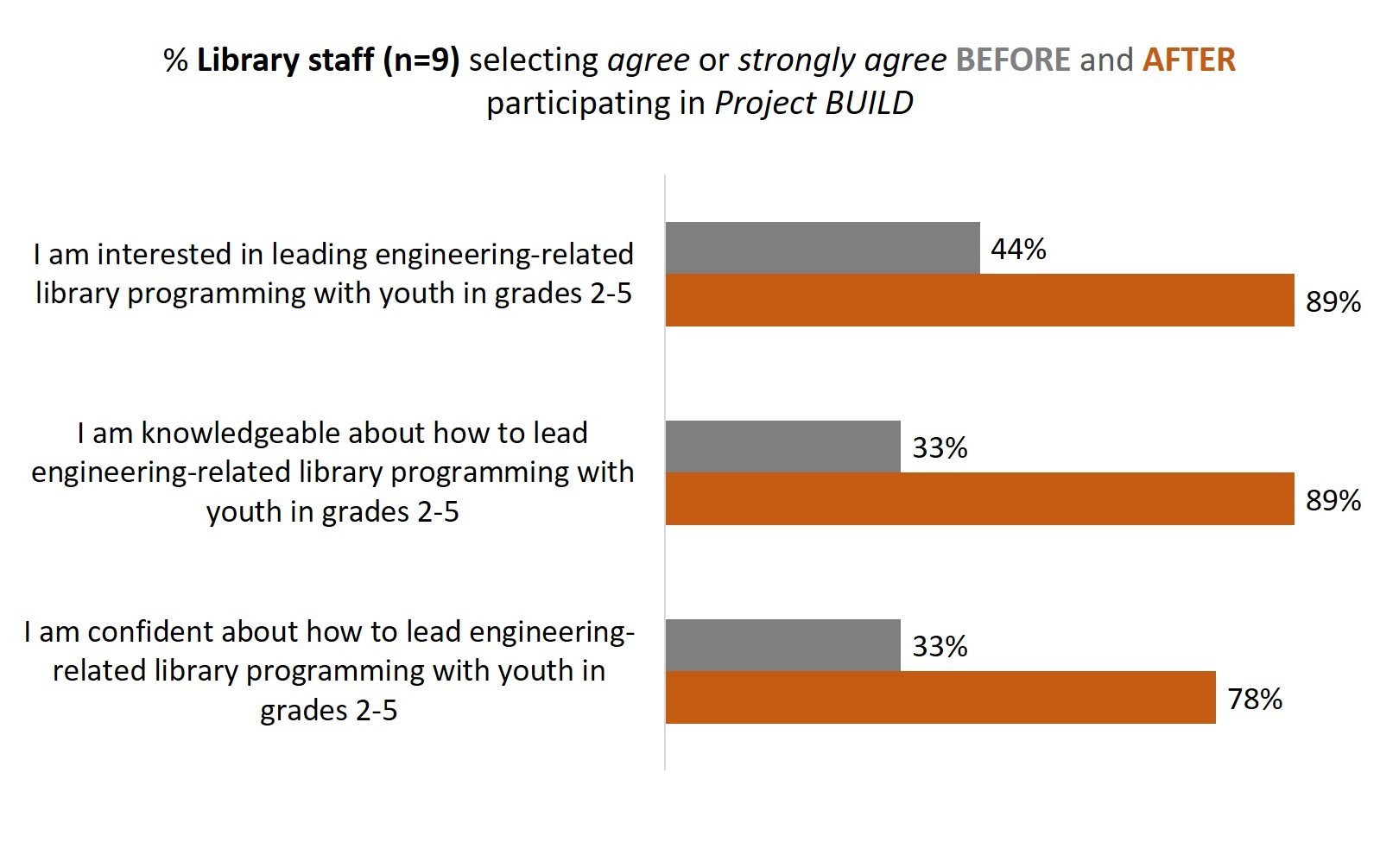
Helping Engineers and Library Staff Work Together
Through the course of the project, library staff and engineers learned a great deal about working together. These lessons learned are also relevant to any setting where educators are interested in partnering with STEM professionals to co-facilitate learning activities. The following key lessons were learned using the project evaluation findings:
- A common understanding of the roles of library staff and engineers is vital. Library staff and engineers stressed that it was very important to establish the roles and responsibilities early in the partnership, discussing their strengths and goals to ensure everyone has a common vision of how the program will run. If possible, it helps to meet in person to discuss who does what during each program.
- Designated points of contact (library staff and engineers) are very helpful for coordination and communication. Library staff and engineers mentioned that it’s important to have a lead person, or persons, representing both the library and the volunteer engineers who are passionate about the project. These individuals can be the key contact persons through which communication can be funneled to ensure consistency and help smooth the process of program planning.
- Engineers need to become familiar with the rules and norms of volunteering with a library. A few library staff and engineers mentioned that it was important for engineers to be aware of the library’s rules and policies (e.g., safety and privacy rules, policies about food). Discussing rules and policies keeps the library staff and engineers on the same page, and any concerns can be addressed in advance.
- Common challenges can include timing, scheduling, and distance. Many engineer volunteers lived and worked in a different city from the library, with some driving 45 minutes or more to help during the program. There were also challenges in scheduling the programs because engineers are generally not available to volunteer during working hours.
The ultimate benefits of the partnership far outweighed the learning curve of working together. The pairing allowed engineers and library staff to complement each other’s strengths, so that they felt more comfortable facilitating the activities. Engineers valued library staffs’ expertise in working with youth and appreciated that they took the lead in planning program activities and logistics, which made it easier for volunteers to participate in outreach. Librarians acknowledged the dedication and enthusiasm of their engineer partners and valued their content knowledge because it exposed their patrons to real-life engineers and made library staff feel more comfortable presenting this type of program.
Program Outcomes for Youth
Surveys were collected from youth following each library program to gain an understanding of their experience with the program and thoughts about engineering. As shown in Figure 3, findings from over 300 youth participating in Ready, Set, Create library programs indicated that the majority learned about engineers and engineering and are interested in continuing to engage with engineering-related activities and learning. Most agreed that they would like to do similar activities (88%) and learn more about engineering and science (80%) after participating in the program. Most youth also agreed that they learned about what engineers do (82%) and understood the key engineering concept that “it can take many tries to solve a problem” (89%).
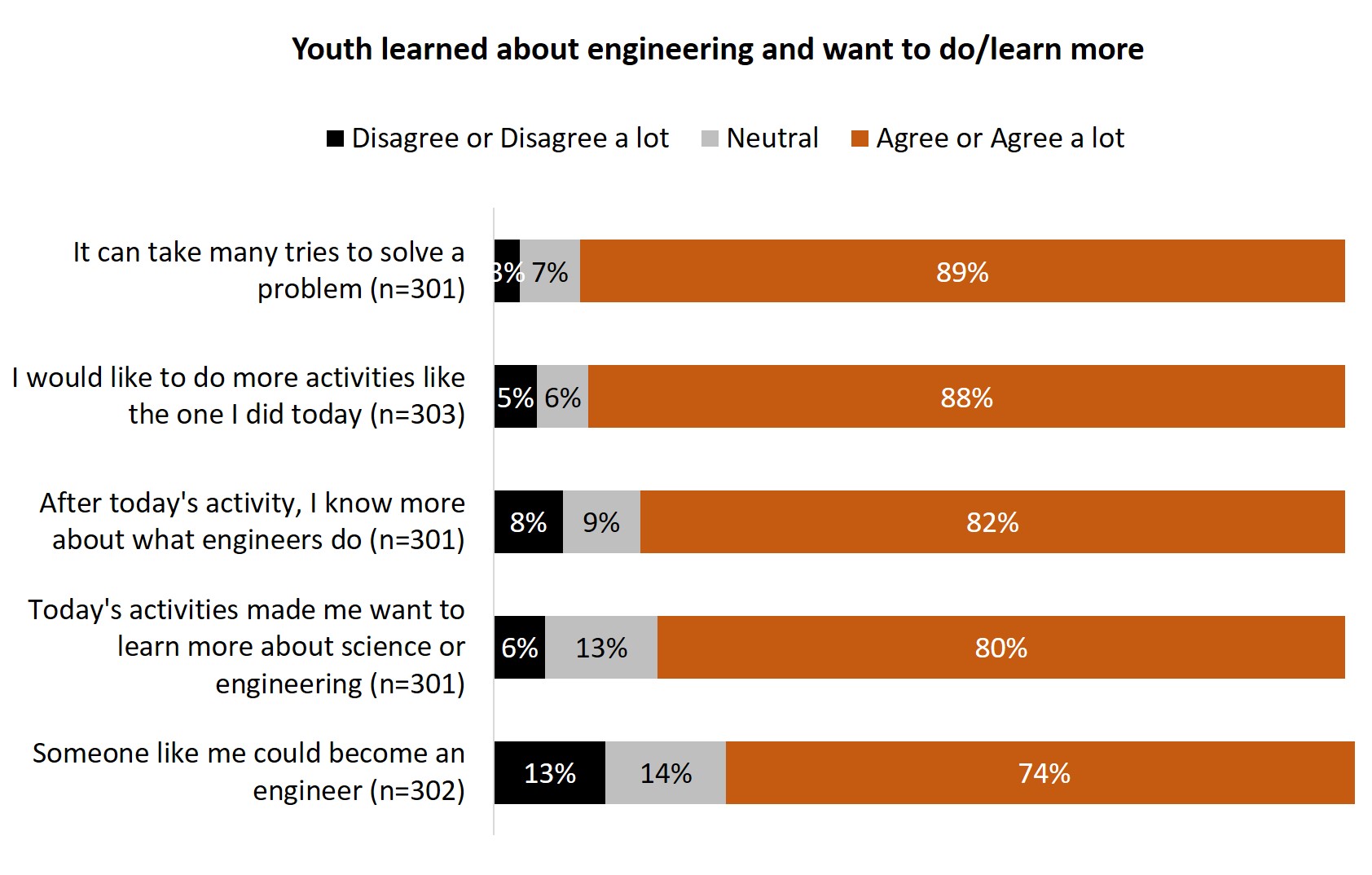
Furthermore, when asked to identify specific activities that an engineer would do for his or her job, each engineering-related activity listed was selected by at least two-thirds of youth (Figure 4). Youth were most likely to select that engineers work with others (86%), they test ideas (75%), and they solve problems (75%).
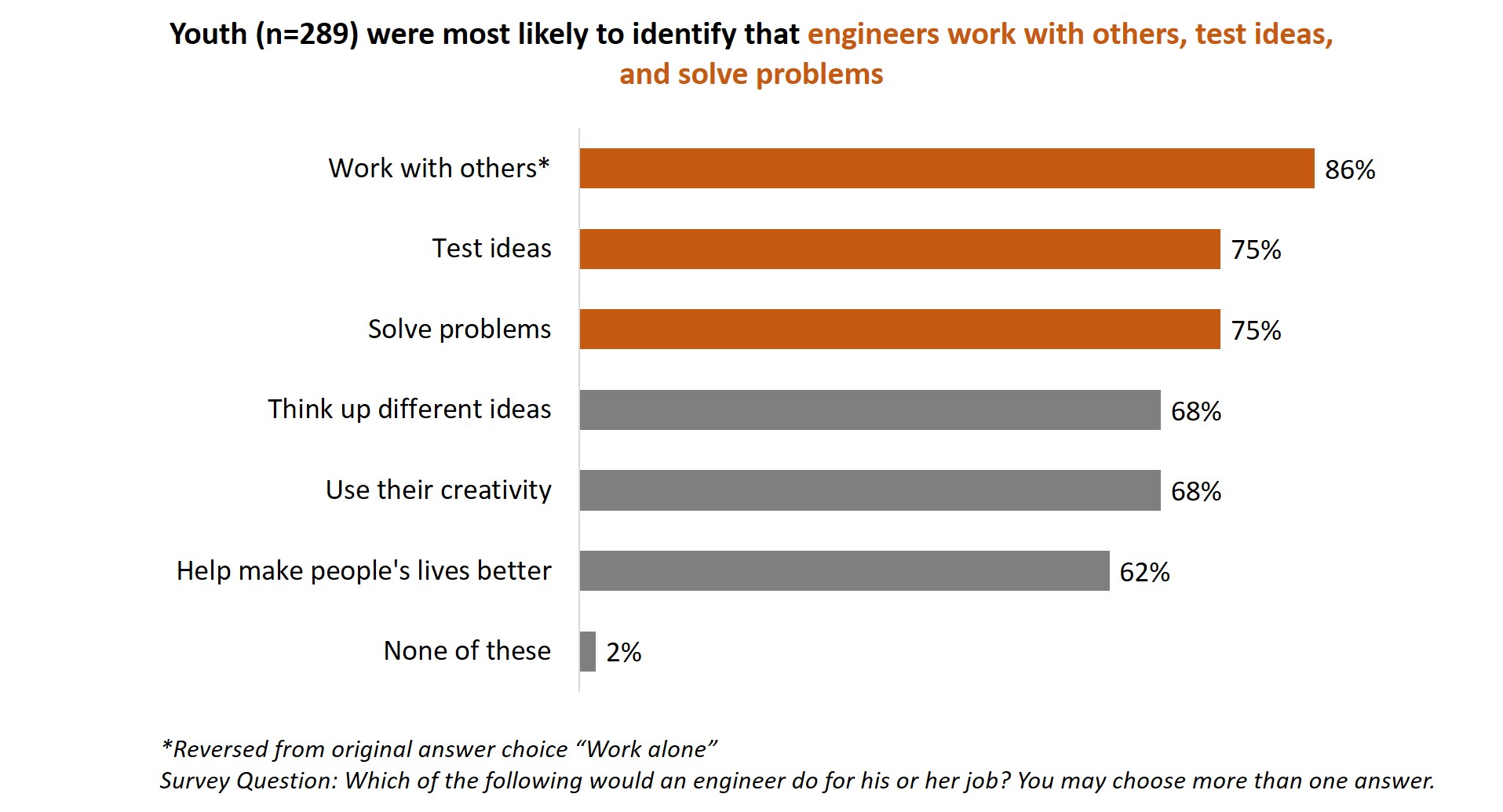
When asked to what they enjoyed about the Ready, Set, Create activity they had just participated in (Figure 5), youth were most likely to indicate that they enjoyed the chance to do things they don’t normally do (62%) and work on interesting problems (60%).
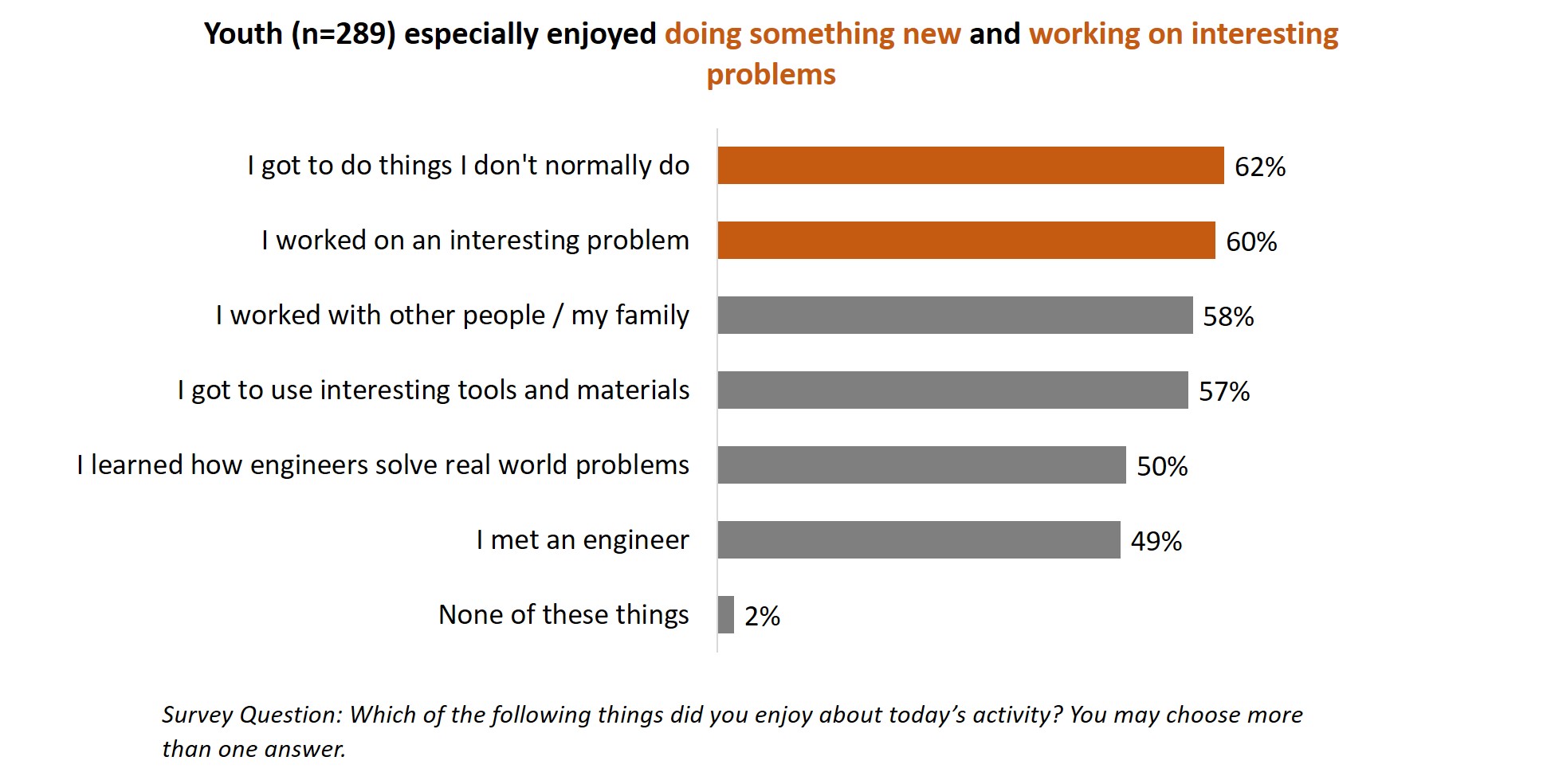
Library staff and engineers felt that the library programs were beneficial for youth because the activities allowed them to engage in open-ended, collaborative, hands-on design challenges; exposed youth to a diverse group of engineers; connected engineering to real-life; and provided youth with the opportunity to practice engineering-related skills.
Program facilitators provided numerous examples of the positive impacts they saw the program having on youth. Some examples are shared below.
“[During the water filter activity] I literally stood there for 20 minutes, pouring water out and the kids would come up, test their design. They'd look at the water. Go back and try to figure out how to make it better. I was amazed that we spent that long because they just kept reiterating their designs.”
"[We shared local examples of engineering] and [youth] were like, hey, I recognize that or I’ve driven across that or my parents talk about that. It was that relationship between what they see every day and kind of what they're learning."
“When you show them a real world application, we don’t just crunch numbers all day. I think that helps them understand better what we do.”
"When the kids you're seeing look a little more like you. It's like I can do it. I can do it. It's a possibility for me."
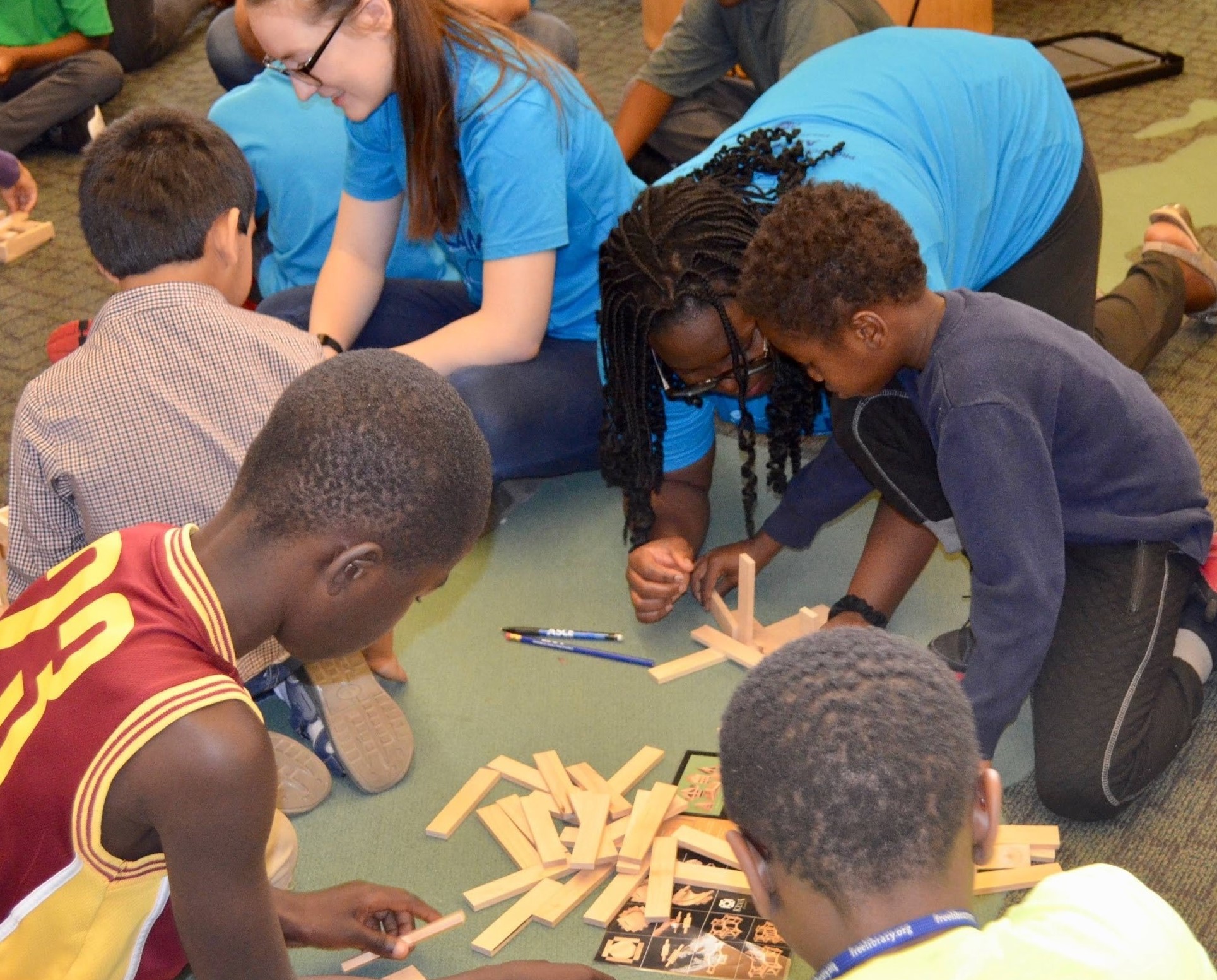
Virtual Dream, Build, Create Events and Lessons Learned for the Future
With many libraries across the country closing their doors to in-person programming because of the COVID-19 pandemic, there was a need for virtual programming to take its place. A similar need was also felt by schools and caregivers searching for quality online resources to engage youth.
Through Project BUILD, ASCE and NCIL developed a new initiative entitled Dream, Build Create aimed at youth in grades 4 and up. In collaboration with STAR Net, Portal to the Public developed a virtual interaction framework that was a useful foundation for this initiative. Through this virtual program, Project BUILD was able to offer the award-winning documentary, Dream Big: Engineering Our World (available in both Spanish and English), to libraries and to the broader network of outreach connections established by ASCE, which included schools and after-school centers. Many public libraries also connected with their local schools and school districts to promote the program. Currently available on Netflix and to rent/own through Vimeo and Amazon, the film was available for free on certain dates in November 2020. In addition, six panels of young engineers (“Dream Teams”) were recruited, prepared, and met online to share their engaging stories of what it means to be an engineer. In total, Dream Big: Engineering Our World was screened over 1,000 times and Dream Team Panel videos have been viewed more than 900 times.
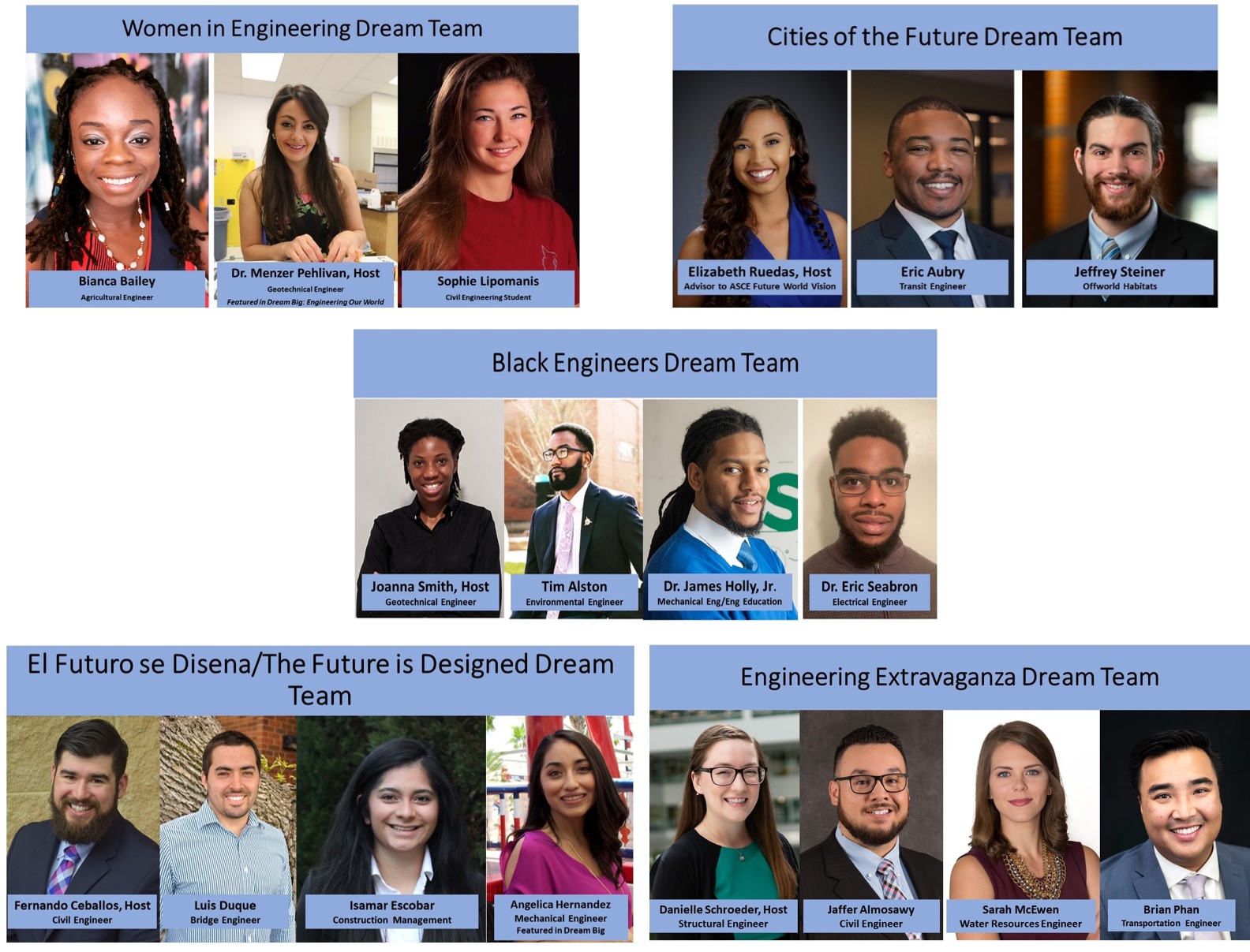
Diverse engineers were recruited through ASCE’s large membership and connections. Individuals with a strong interest in pre-college outreach were invited to be a part of engaging online engineer panels and give youth an opportunity to meet engineers who would share their experiences and answer questions. Engineers for Dream Team panels were chosen by ASCE staff, members of the Society of Hispanic Professional Engineers, and faculty/alumni networks from Historically Black Colleges and Universities. Panelists were selected because they possessed expertise in the topic, had an engaging personality, and were diverse; half of the panelists were female, 28% were Latinx, and 33% were Black. Dream Team panel topics included:
- Women in Engineering and Black Engineers: Two panels featured groups that are underrepresented in the engineering profession.
- El Futuro se Diseña/The Future is Designed (Spanish Language): Having the ability to offer the Spanish-language version of Dream Big: Engineering Our World prompted the idea of hosting a Dream Team in Spanish, which also allowed another underrepresented group to be highlighted.
- Cities of the Future: ASCE is currently developing a project called Future World Vision, which will be a tool for civil engineers to use in envisioning the world 50 years from now. Cities under development include: Floating City, Mega City, Rural City, Frozen City, and Offworld City. Talking about how engineers are already developing these future scenarios provided an opportunity to present engineering as a creative, problem-solving profession.
- Engineering Extravaganza: This Dream Team was envisioned as an opportunity to showcase a variety of civil engineering disciplines and engaging activities.
Although the topics varied, each Dream Team had a similar format. Engineers talked about what led them to engineering, what they love about their work, and how engineering involves creativity and problem solving. During each Dream Team, one or more of the panelists modeled a Project BUILD–style engineering activity, showing how it can be done at home. Different activities were demonstrated at each panel, and information on where to go for more information was part of the closing slides.
Each engineer also received a list of questions developed from the report “Despite the Odds: Young Women Who Persist in Engineering” (DiscoverE, December 2019). The report identifies key factors for young women who choose engineering as a career and/or persist in engineering and formed a foundation for hosts to use in facilitating the discussions. Although this report dealt with women, the key factors have the potential to apply to other groups underrepresented in STEM. Hosts and panelists reviewed topics in advance and panelists identified questions that they particularly wanted to answer. Questions from the audience were also encouraged.
Project evaluators surveyed library staff, teachers, and caregivers who registered for the Dream, Build, Create program and also spoke with a sample of library staff and teachers. In total, 151 surveys were completed and 10 individuals (eight library staff and two teachers) participated in virtual focus groups. Results suggest that Dream, Build, Create provided an opportunity that has value beyond the COVID-19 pandemic. Library staff, especially those from rural areas, felt this program was highly valuable and important because they and their patrons do not always have access to engineers in their local community. Teachers also noted that they can face challenges providing students with in-person opportunities to engage with engineers. In fact, only about one-third or fewer of library staff, teachers, and caregivers indicated that they had opportunities to provide youth with access to programs featuring real engineers (i.e., in-person or virtual talks, screenings of engineering-related films). While in-person activities will certainly return as a staple for libraries in the future, it was also noted that virtual programs such as this have a life beyond the pandemic because of their ability to provide a connection to people and resources that individuals may not otherwise have access to.
Additionally, library staff and teachers noted that both the documentary and panels helped showcase passionate, diverse engineers. This not only helped youth learn about the work of engineers and how they are making the world a better place, but also sent an inspirational message that opened youths’ eyes to new possibilities. Those serving populations traditionally underrepresented in STEM especially valued the representation present in the film and panels since underrepresented youth do not often see engineers that look like them. As one library staff member commented, "I had very positive feedback [from a teacher]. [The program] opened the students' eyes to what engineers do and there are no limits on who can take part in a STEM career." See the Dream, Build, Create final report for more information about the event.
Conclusion
Project BUILD (both the in-person and virtual programs) uses connections between library staff, engineers, and their communities to help bridge the gap between in-school and out-of-school settings. Based on results of Project BUILD, both in-person and virtual programs can connect youth with diverse engineers and showcase the various ways engineers work to make the world a better place. Although in-person programming allows for more direct interaction between engineers and participants, virtual programs are a valuable alternative, especially in areas where it would be difficult to bring the engineers and youth together in-person.
Project BUILD demonstrates that educators and professionals can effectively work together to engage youth and support their learning. However, these partnerships require preparation and a commitment to work through challenges. Partners must outline clear roles and responsibilities and promote an understanding of the norms of the learning environment. Passionate individuals must be willing and able to serve as points of contact and coordinate the work.
It is important to continue to prepare engineers and educators to engage with youth and offer programs that connect engineers with young people to foster youths’ interest in engineering, inspire them, and open their eyes to the fact that anyone can be an engineer. The project found that engineers and library staff gained confidence in engaging youth in engineering-related activities through participation in the project. Engineers who become more comfortable working with young children can continue to apply those skills in other formal and informal settings. Additionally, as libraries build their capacity to offer engineering-related programming, they can leverage their partnerships with K–12 schools to bring the activities to teachers and students. Once the foundation is set, engineers and libraries can continue to provide access to relevant and fun programs for youth in their community.
Acknowledgment
This work is supported by the National Science Foundation under Grant Number DRL-1657593. Any opinions, findings, and conclusions or recommendations expressed in this material are those of the author(s) and do not necessarily reflect the views of the National Science Foundation.
Jennifer Jocz (jjocz@edc.org) is a Senior Research Associate at Education Development Center in Waltham, Massachusetts, Paul Dusenbery is a Senior Education Associate at Space Science Institute in Boulder, Colorado. Keliann LaConte is a Senior Education Associate at Space Science Institute in Boulder, Colorado. Jeannine Finton was the Sr. Manager of Pre-College Outreach at the American Society of Civil Engineers in Reston, Virginia, and is currently a freelance STEM consultant.
citation: Jocz, J., P. Dusenbery, K. LaConte, and J. Finton. 2021. Ready, Set, Create: Engineers inspiring youth to build their dreams. Connected Science Learning 3 (3). https://www.nsta.org/connected-science-learning/connected-science-learning-may-june-2021/ready-set-create-engineers
Careers Engineering Science and Engineering Practices STEM Informal Education

